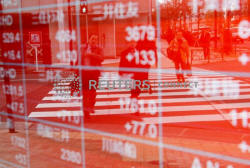Shares and oil at three-month highs but no love for euro
 Send a link to a friend
Send a link to a friend
 [February 14, 2019]
By Marc Jones [February 14, 2019]
By Marc Jones
LONDON (Reuters) - Optimism about
U.S.-China trade talks and bumper earnings lifted European shares to a
three-month high on Thursday, though news that Germany only dodged
recession by the narrowest of margins left the euro feeling unloved.
Markets were generally in a cautious mood as investors hung on for any
hint of progress in the tariff talks amid reports the White House could
extend the deadline for a deal.
Stocks extended gains regardless. Strong results from Nestle, drugmaker
AstraZeneca and plane giant Airbus lifted the pan-European STOXX 600 0.4
percent and toward its best week since early November. [.EU]
"Cupid continues to shoot out bullish arrows across financial markets
with last week’s blip almost forgotten about for now," Deutsche Bank
said in a Valentine's day morning note.
The euro did not share the loving feeling however.
It struggled near a three-month low [/FRX] as data showed Germany's
economy stalled in the fourth quarter, with fallout from global trade
disputes and Brexit threatening to derail a decade-long expansion in
Europe's economic powerhouse.

Russian stocks and bonds were also dumped as a rare bipartisan move from
U.S. lawmakers proposed stiff new sanctions on Russian government debt
as well as some banks and oil and gas firms.
The Kremlin said it could cope with any new measures but shares in
Moscow tumbled more than 2 percent amid a sharp spike in FX volatility
gauges and a brisk selloff of most rouble-denominated government bonds.
"We were preparing ourselves for this eventuality," said head of EM
sovereign debt at Aberdeen Standard Investments Edwin Gutierrez. "But
this is understandably causing a lot of noise and the U.S. senators have
certainly tightened the language (of sanctions proposals) since last
year."
On China, President Donald Trump said on Wednesday trade talks were
"going along very well" and, with Treasury Secretary Steven Mnuchin and
Trade Representative Robert Lighthizer in China, investors had been
daring to hope for good news.
Bloomberg said Trump was considering pushing back the March 1 deadline
for higher tariffs on Chinese goods by 60 days.
But expectations have been disappointed before, and the reaction in
Asian share markets was guarded. Shanghai blue chips closed broadly
flat, having jumped 2 percent on Wednesday to levels last seen in late
September.

MSCI's broadest index of Asia-Pacific shares outside Japan eased 0.15
percent, though that was off a peak last seen in early October and
Japan's Nikkei finished flat having briefly touched its highest level
this year.
[to top of second column] |

Pedestrians are reflected on an electronic board showing stock
prices outside a brokerage in Tokyo, Japan December 27, 2018.
REUTERS/Kim Kyung-Hoon

LOVE SPREADS AROUND
The Australian dollar, often used as a liquid proxy for China risks, gained 0.4
percent to $0.7114 and S&P 500 futures added 0.15 percent having closed above
its 200-moving average for the second running on Wednesday. [.N]
The Aussie dollar had already got a small lift when Chinese trade data handily
beat expectations in a welcome relief for the global economy.
Beijing reported exports rose 9.1 percent in January from a year earlier,
confounding forecasts of a fall, while imports dipped by a surprisingly slight
1.5 percent.
The recent improvement in risk appetite undermined the safe haven yen though and
propelled the dollar to its best levels of the year so far at 111.05.
The subdued European data though, which also saw Italy confirmed in recession,
pushed long-term market inflation expectations to new lows, while putting
downward pressure on bond yields in the bloc.[GVD/EUR]
The euro was at $1.1265, not that far above the floor of a $1.1213/1.1570
trading range that has held since mid-October.
Sterling was also on edge at $1.2845 ahead of another parliamentary vote on
British Prime Minister Theresa May's Brexit plan.
That all left the dollar near its highest since mid-December against a basket of
currencies at 97.059.
In commodity markets, spot gold edged up 0.18 percent to $1,308.56 per ounce.

Oil prices found support as top exporter Saudi Arabia said it would cut crude
exports and deliver an even deeper output cut. [O/R]
U.S. crude was up 56 cents, or 1 percent, at $54.42 a barrel, while Brent crude
futures rose 97 cents to $64.50, its highest since November.
"Thanks to healthy oil demand growth and lower OPEC+ production ... we see the
market tightening further over the coming months," UBS analyst Giovanni Staunovo
said.
"As such, we continue to expect Brent oil prices will move up to $70–80 a barrel
over three to six months."
(Additional reporting by Sujata Rao in London, Wayne Cole in Sydney; Editing by
John Stonestreet and Andrew Cawthorne)
[© 2019 Thomson Reuters. All rights
reserved.] Copyright 2019 Reuters. All rights reserved. This material may not be published,
broadcast, rewritten or redistributed.
Thompson Reuters is solely responsible for this content. |